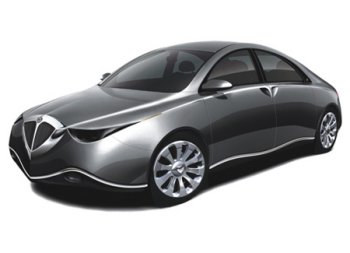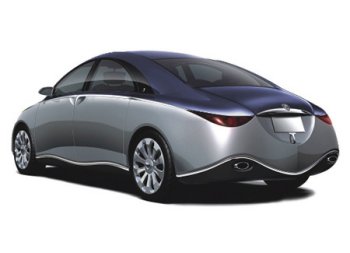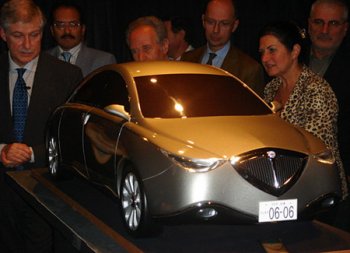|
Enrico Fumia,
renown for styling the Lancia's Y and Lybra models as well
as the Maserati 3200GT and the Alfa Romeo GTV and 164
models, has created a new scale model proposal - the Lancia J - which
pays tribute to the marque on the important occasion of its 100th
anniversary. As usual for Fumia, the design of the Lancia J
is controversial: a combination of pushing forward new ideas
and utilising his favoured approaches such as a symmetrical
approach to styling.
The Turin based Fumia Design Associati is led by Enico Fumia,
who cut his teeth under the direction of Nuccio Bertone, and
who as well as this string of well-received production
models has also created several groundbreaking concept cars
such as the Audi Quartz (1981). Other non-production
projects include the Fiat Strada 105TC-based Alfa "Brio"
showcar (Geneva 1983) and further back in 1966 when he was
resident at Bertone, the Grifo d'Oro. More recent projects
include the one-off F90, based on the Ferrari Testarossa
chassis (1988) which was created for a Japanese enthusiast.
He has a more recent tradition of focusing on the growing
need for solutions to city transportation requirements: his
trio small car concepts - Xstile, Xport and Xsmall - were
shown at the Turin Motor Show in 2000, while another small
'city car' proposal, CityCat Jod-Jod was shown in Bologna in
2004. Last year he created WOW16, another very small car
proposal built for burgeoning Chinese carmaker Chery, and
shown at the Shanghai Motor Show. Aside from cars he has
created innovative automotive solutions to the actioning of
folding roofs, concealed rear wiper arms and blades
(patented by Lancia for the Y and Lybra models) as well as a
string of non automotive products, including golf clubs and
revolutionary air-conditioning systems.
|

 |
|
The Lancia J
model instinctively explores one of the designers underlying
individual trends, a call for symmetry in a car's overall
design, distinct traits seen in recent years in his
symmetrical 'Xstile' and 'Xport' city car designs. |
|
 |
|
|
 |
|
Enrico Fumia presents his tribute to Lancia's 100th
anniversary, with a model that cements his long standing relationship with
the Fiat Auto-owned brand, the Lancia J. |
|
 |
|
|
Now Fumia presents his own individual tribute to Lancia's 100th
anniversary, with a scale model that cements his long standing relationship with
the Fiat Auto-owned brand, the Lancia J. His idea has focused around
a new flagship saloon, a successor to the Lancia Thesis
model which has struggled to find an appreciative audience
in the marketplace during the five years it has been in
production. Fumia's concept is an unusual design but aims to
reflect a luxurious, comfortable and practical saloon, which
reflects Lancia's brand values with its retrospective
touches and its call on a long heritage.
The Lancia J
model instinctively explores one of the designers underlying
individual trends, a call for symmetry in a car's overall
design, distinct traits seen in recent years in his
symmetrical 'Xstile' and 'Xport' city car designs. Now Fumia
has evolved this original train of thinking and adapted it
to the requirements of a large executive saloon. His use of
symmetry allows the incorporation of rear doors which are
hinged at the C-pillar to be a natural overall feature of the car, while
the removal of the B-pillar is a twist on Lancia's thinking
in recent years - it was was a feature of the luxurious and
innovative 'Diagalos' concept car, shown in 1998, which
partially evolved into the
Thesis, and which without the hindrance of the centre pillar
explored the 'living room' concept to the full. Many of the ideas tested
on "technology showcase" Diagalos were then incorporated into the
production Thesis, not least the
overall form.
The overall shape of the car arches sharply upwards with
this feature impressed on by the high centre. The quirky styling of the Lancia J is
complemented by some edgy touches, such as the undulating
front and rear bumpers which chase round into similar
flowing sill
mouldings. These lines in turn are drawn from the shape of
the prominent front Lancia radiator grille while the overall
theme of design symmetry continues with features such as the
narrow headlights and tail lights with curve to pointed
edges, the door drop-glass and exterior opening handles, the
front and rear screen, and the positioning of the front
foglights and rear exhaust tailpipe exits.
Bowing to a recent but now very established Lancia tradition, Fumia
also envisions a bi-colore
version.
|
|
|
|